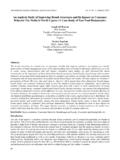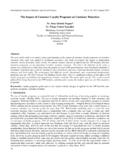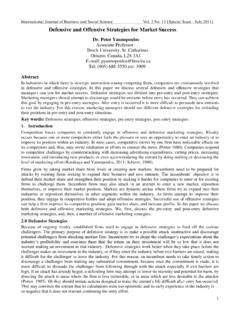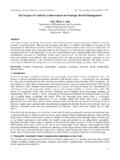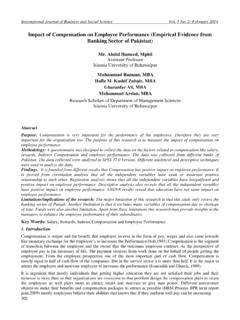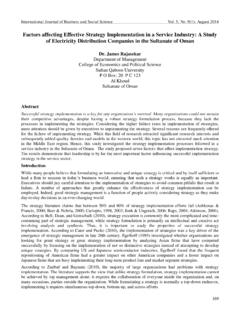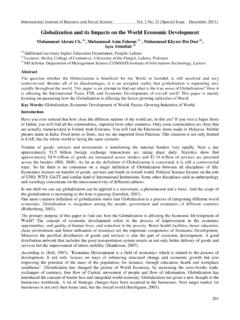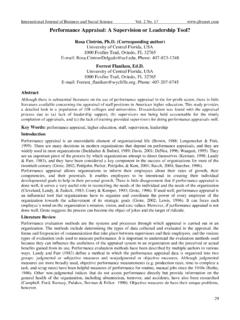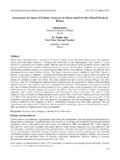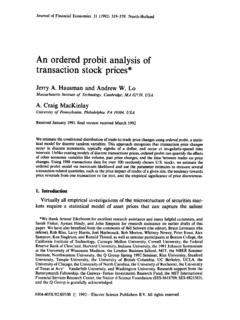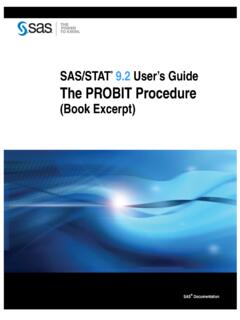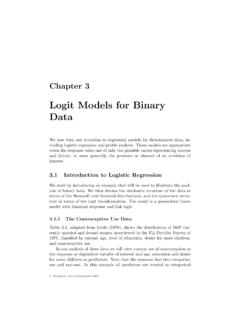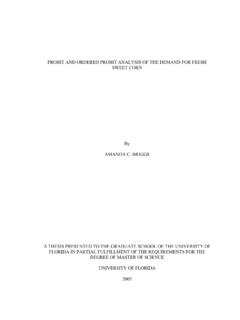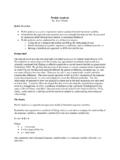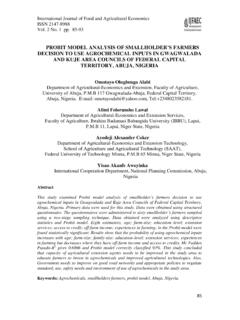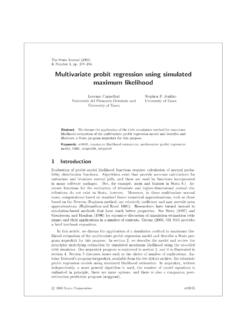Transcription of Predicting the Default Characteristics of Microfinance ...
1 4201 April ; 5(1) No. 5,Vol. International Journal of Business and Social Science 291 Predicting the Default Characteristics of Microfinance Borrowers in Turkey: A probit analysis Eyub Yegen Department of Accounting, Finance, and Law. State University of New York at Oswego Abstract This article is the first complete study that identifies the common idiosyncratic Characteristics of defaulted Microfinance loans in Turkey by using a probit analysis . The study is based on 104,393 observations from a pooled data that was provided by the Turkish Grameen Microfinance Program (TGMP). Three models were designed and two tests were used in attempting to find the appropriate decision model to identify Default . According to the hypothesis test results of the most appropriate model, seventeen variables were highly significant at the one percent level.
2 This probit model may be used by Turkish Microfinance institutions as a criterion to identify the likeliness of potential borrowers repayments. Keywords: Decision Model, Microfinance Repayment, Microcredit Default , Microfinance Default , probit analysis , Women Entrepreneurs, Loan Repayment. 1. Introduction Millions of people around the globe are aware of the unfortunate facts of unsolvable poverty and its consequences. Governments, non-profit organizations, corporations and others have spent trillions of dollars to fight poverty, but still eighty percent of humanity lives under $10 a day (Ravallion, et al, 2008). Many experiments and studies have been executed in order to find ways to make development policies more efficient to decrease inequality, poverty, and to achieve the United Nations Millennium Development Goals(Littlefield, et al, 2003; Yunus 2003, 2004).
3 Unfortunately, even now, no one has found a solution that will eliminate poverty. While this does not imply that donor aid, as it exists today, does not work, the persistence of poverty calls into question the amount of money spent on traditional development programs (Karlan and Appel 2011). Microfinance has been on the market for decades, providing loans to individuals that were neglected by traditional financial intermediaries (Yunus 2011). This financial innovation brought about positive changes to millions of lives (Durrani, et al, 2011). The history of Microfinance starts in the eighteenth century. Jonathan Swift, an Irish author and politician, inspired one of the very first Microfinance organizations, the Irish Loan Funds system that reached its peak loan coverage of twenty percent of Irish families during the 18th century (CGAP 2006). Microfinance innovation has become a popular development instrument that has been adopted by many nations.
4 Yunus entered the Microfinance business when he lent his initial $27 to 42 bamboo craftswomen (Yunus 2004; Gangemi 2005). This successful venture encouraged him to continue his Microfinance journey that eventually designated him as being the father of Microfinance as well as being the founder of Grameen Bank, a non-profit organization that serves over six million clients with a loan portfolio of $650 million (Karlan and Appel 2011). This won for him and his organization the honor of becoming the 2006 Nobel Peace Laureate (Hesser 2006; Friedman and Aziz, 2012). Today, over 155 million low-income individuals, mostly women (UNCDF 1997; Adebayo 1997; Adeyeye 2003; Morvant-Roux , et al, 2012 ) are part of the Microfinance family (Leatherman and Dunford 2010; Buera, Kaboski and Shin 2012 ). Based on the stories of Microfinance clients, Microfinance has made dreams happen and changed lives (Khandker 2005; Aziz, et al, 2013).
5 Still, this is neither an indicator that Microfinance has been used at its most efficient capacity, nor does it indicate that Microfinance has increased all of its clients standards of living (Westover 2008). Some tests in South Africa and the Philippines and a recent study that was conducted in Bosnia and Herzegovina by Britta Augsburg, et al (2012), are used to identify the impacts in different ways of the Microfinance clients lives and the success of repayments based upon different requirements. Center for Promoting Ideas, USA 292 Nonetheless, there are not many studies that analyze the Characteristics of Microfinance loan defaults and no study that particularly focuses on Turkey in terms of Microfinance defaults. As previously mentioned, in order to maximize the effect of Microfinance on reducing poverty, it is necessary to analyze the idiosyncratic reasons of common Default Characteristics .
6 By doing so, managers of Microfinance institutions (MFIs) in Turkey can reduce the prevalence of bad loans and find ways to guide Microfinance clients to overcome these problems (Yildirim 2008). This study uses a probit analysis to identify the common Default Characteristics of 104,393 observations conducted by the Turkish Grameen Microfinance Program (TGMP). Among the recent publications and studies on Microfinance , relatively few researchers used a probit analysis in their studies, and just a couple of these researches specifically focused on the Characteristics of Microfinance defaults by using a probit analysis . Chirwa used a probit analysis on a dataset conducted in Malawi to determine the probability of credit repayments over ten years ago (1997). However, Chirwa used a stepwise elimination to identify the model s specification of the X-vector (Adeyemo 2007).
7 Stepwise elimination is highly criticized and considered unethical because of the lack of theoretical input and the possibility of biasness and inconsistence when relevant variables were excluded (Cohen and Cohen 2003). Adeyemo, et al, used linear multiple regression analysis on a relatively small sample ( , n=200) to determine the factors that affected Microfinance repayments (2007). Vitor, et al, used a probit analysis to determine loan repayment defaults among farmers in Ghana based on a relatively small sample ( , n=374) (2012). In this article, it is unclear how the small dataset was collected. Therefore, there is a high possibility of selection bias if the clients were not randomly selected (Cortes, et al. 2008). This study will demonstrate an appropriate (and recent) model that may be used by Microfinance institutions in Turkey in order to find the likeliness of a Default .
8 Since the suggested model is based on a study of 104,393 observations, in the probability theory the law of large numbers guarantees that the estimated parameters are converged with the actual parameters as the sample size rises (Hsu and Robbins 1947). Thus, this model can precisely measure the probability that the borrowers in the sample, given a host of Characteristics based on available data, defaulted or not on their loans. 2. The Model In this paper, a probit analysis is applied to a binary choice model to identify the Characteristics of Microfinance borrower who continuously could not finance their loans. TGMP has tried to secure itself by not allowing defaults. However,since there are no regulatory protections and screening mechanisms ( , credit bureaus), it can be more expensive for the Microfinance organization to overcome such asymmetric information problems (Pham, et al, 2008).
9 In order to be more cost efficient and achieve the purpose of Microfinance , while also keeping in mind the best interests of low-income individuals, MFIs must lower these opportunity losses. Throughout this paper, borrowers who could not refinance their loans within 46 weeks are considered as defaulters. In the models it is assumed that the error terms are homoscedastic and normallydistributed with a mean of zero, and a variance of . Since one variable contains a large amount of incorrect information, there are three models constructed in order to test which model is more appropriate by using one t-test and one likelihood-ratio test. For all models, the dependent variable is the qualitative variable, Defaulted, which means a borrower has not been able to pay back her loan within 46 week maturity deadline. This dependent dummy variable may be represented as follows: =1<=> 0 =0 <=> <0 For model I, the probability of choosing =1 ( , Default is present) is given by: ( =1)= ( 0)=Prob( 0 + 1 balance_on_savings + 2 Mediterr + 3 Southeast + 4 Aegean + 5 Marmara+ 6 Central + 7 Black_Sea + 8 Age+ 9passive + 10 years_active__passive_or_active + 11ag + 12loannumber + 13insurance_1 + 14total_loan_amount + 15outstanding_loan+ 16married + 17 widowed_separated_divorced + 18household_size + 19 established_business- ui 0) (1)= ( + _ _ + + _ ) = ( [ + _ _ + + _ ]/ [ / ]).
10 4201 April ; 5(1) No. 5,Vol. International Journal of Business and Social Science 293 To simplify the calculation let Zi*=[ + _ _ + + _ ]/ . Using this new definition: ( =1)= = , where stands for the cumulative probability function for a standard normal variate, the first probit model is given by: (Defaulted=1)= ( + _ _ + + _ ). (2) For model II, the variable years_active_passive_or_active was excluded because it contained 13,590 observations with errors, which is not having an exit date entered into the system. The probability of ( =1)= ( 0) choosing =1 ( , Default is present) for the second model is given by: Prob( 0 + 1 balance_on_savings + 2 Mediterr + 3 Southeast + 4 Aegean + 5 Marmara+ 6 Central + 7 Black_Sea + 8 Age+ 9passive + 10ag + 11loannumber + 12insurance_1 + 13total_loan_amount + 14outstanding_loan+ 15 married + 16 widowed_separated_divorced + 17household_size + 18established_business- ui 0) (3)= ( + _ _ + + _ )= ( [ + _ _ + + _ ]/ [ / ]).
